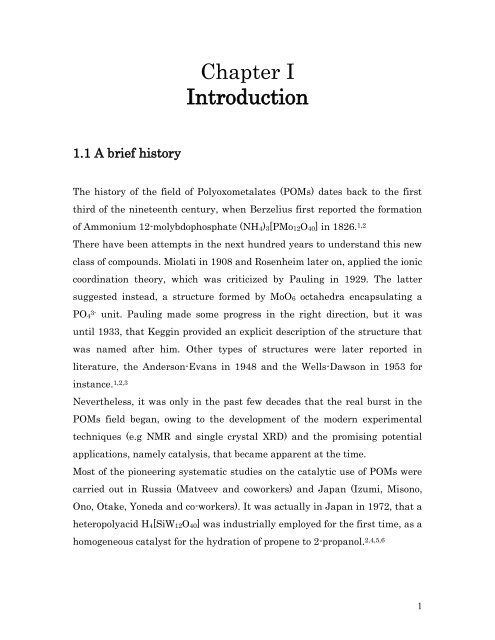Synthesis, Structure and Catalytic Activity of ... - Jacobs University
Synthesis, Structure and Catalytic Activity of ... - Jacobs University
Synthesis, Structure and Catalytic Activity of ... - Jacobs University
You also want an ePaper? Increase the reach of your titles
YUMPU automatically turns print PDFs into web optimized ePapers that Google loves.
Chapter I<br />
Introduction<br />
1.1 A brief history<br />
The history <strong>of</strong> the field <strong>of</strong> Polyoxometalates (POMs) dates back to the first<br />
third <strong>of</strong> the nineteenth century, when Berzelius first reported the formation<br />
<strong>of</strong> Ammonium 12-molybdophosphate (NH4)3[PMo12O40] in 1826. 1,2<br />
There have been attempts in the next hundred years to underst<strong>and</strong> this new<br />
class <strong>of</strong> compounds. Miolati in 1908 <strong>and</strong> Rosenheim later on, applied the ionic<br />
coordination theory, which was criticized by Pauling in 1929. The latter<br />
suggested instead, a structure formed by MoO6 octahedra encapsulating a<br />
PO4 3- unit. Pauling made some progress in the right direction, but it was<br />
until 1933, that Keggin provided an explicit description <strong>of</strong> the structure that<br />
was named after him. Other types <strong>of</strong> structures were later reported in<br />
literature, the Anderson-Evans in 1948 <strong>and</strong> the Wells-Dawson in 1953 for<br />
instance. 1,2,3<br />
Nevertheless, it was only in the past few decades that the real burst in the<br />
POMs field began, owing to the development <strong>of</strong> the modern experimental<br />
techniques (e.g NMR <strong>and</strong> single crystal XRD) <strong>and</strong> the promising potential<br />
applications, namely catalysis, that became apparent at the time.<br />
Most <strong>of</strong> the pioneering systematic studies on the catalytic use <strong>of</strong> POMs were<br />
carried out in Russia (Matveev <strong>and</strong> coworkers) <strong>and</strong> Japan (Izumi, Misono,<br />
Ono, Otake, Yoneda <strong>and</strong> co-workers). It was actually in Japan in 1972, that a<br />
heteropolyacid H4[SiW12O40] was industrially employed for the first time, as a<br />
homogeneous catalyst for the hydration <strong>of</strong> propene to 2-propanol. 2,4,5,6<br />
1

















